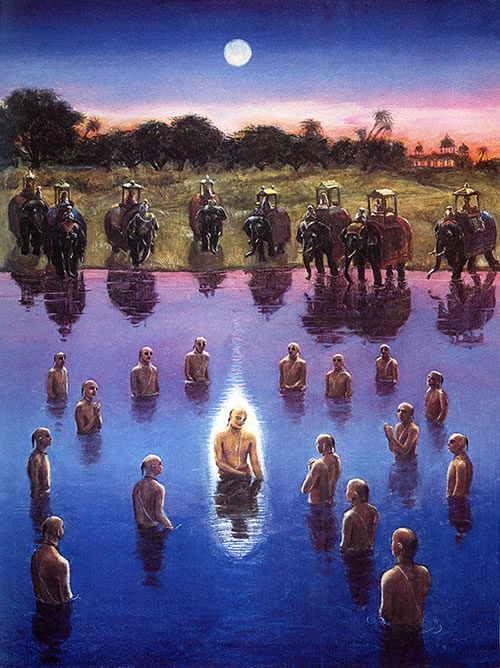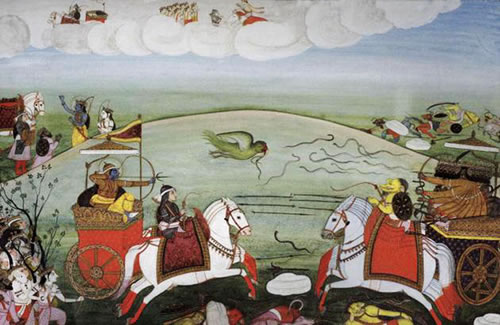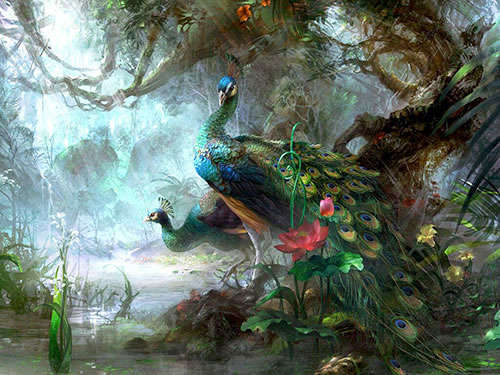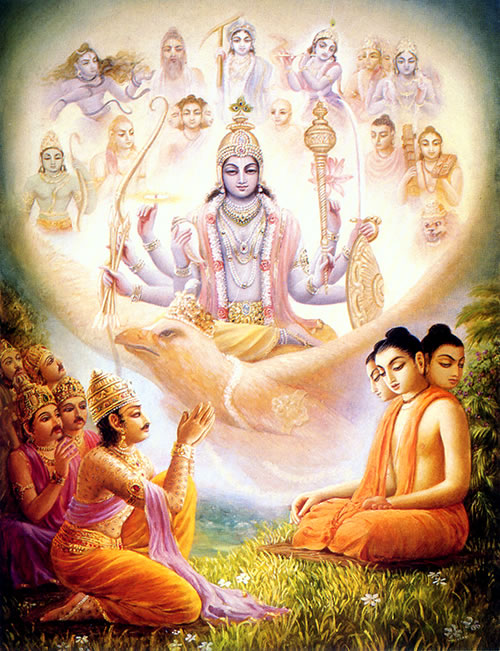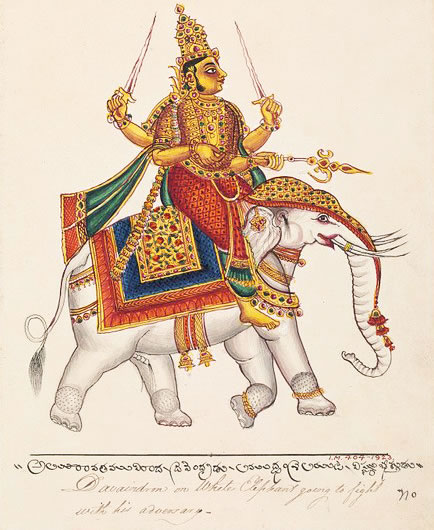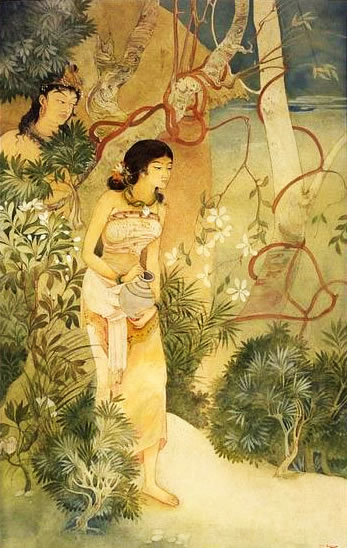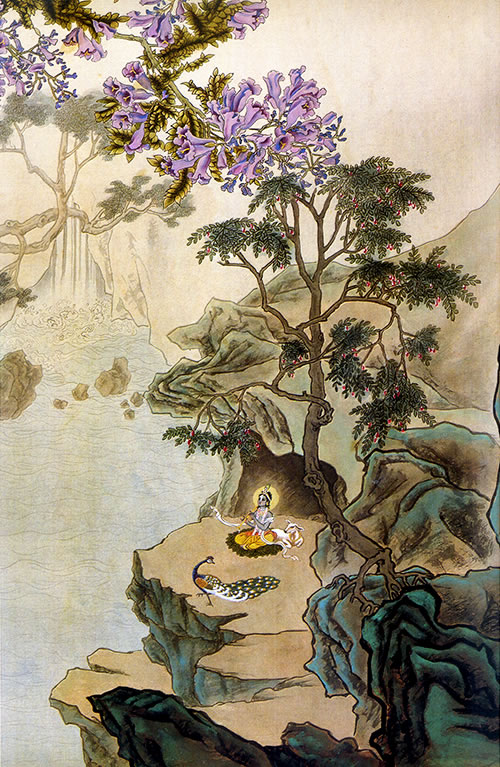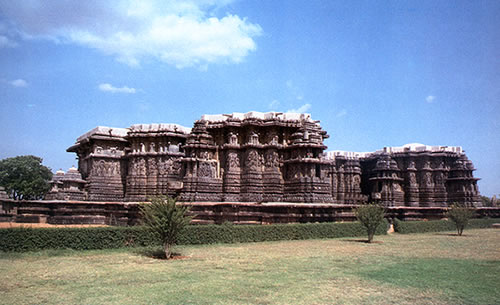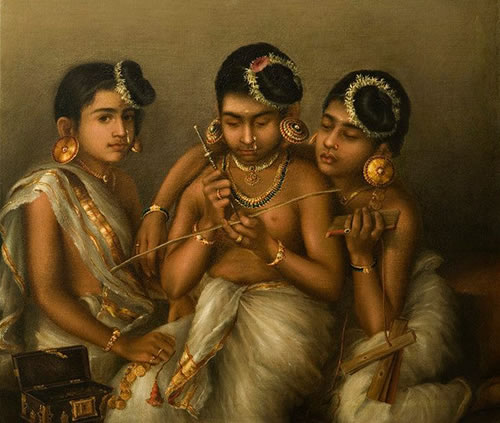On the Authenticity of the (Modern)
Brhat Parasara Hora Sastra
Shyamasundara Dasa
Copyright © 2009-2017
This article first appeared in the July and August, 2009, issues of The Astrological eMagazine, Bangalore. Get the PDF version of this article in German.
How Brhat Parasara Hora Sastra
Became Gospel
Ever since 1984 with the publication of the first volume of Brhat Parasara Hora Sastra (Parasara, 1984) with translation and commentary by R. Santanam, Brhat Parasara Hora Sastra (henceforth BPHS) has been successfully marketed to Vedic astrologers in India and abroad as the preeminent text on Vedic astrology. Ranjan, the publishers, described it as: “The Gospel Book of Hindu Astrology with Master Key to Divination” (I didn't coin the term “Vedic Astrology” my guru maharaja did, but I did popularize it in 1988). This reputation was further cemented when Sagar published their superior edition of the same work with translation and commentary by Sriman Girish Chand Sharma (Parasara, 1994). (Unless otherwise stated henceforth all references to BPHS will be to this edition.)
The idea that one gets, especially for followers of Lord Krsna's Vedic culture, is that the modern edition of BPHS is a very ancient text dating back to the beginning of Kali-yuga (3102 B.C.). Hence, the views set forth in the BPHS are seen by many as sacrosanct, infallible and on par with sacred scriptures like the Vedas or Srimad Bhagavatam. And, hence BPHS is often quoted as pramana -- authoritative evidence -- in Vedic astrological discourse. But what is the real status of BPHS and the implications to Vedic astrology?
When I first started studying jyotish in India in 1977-1983 there were very few classic texts easily available in English. The main authors to have translated texts were V. Subrahmanya Sastri to whom we owe translations of:
- Brhat Jataka
- Brhat Samhita
- Jataka Parijata
- Sripatipaddhati
- Phaladipika
- Uttarakalamrita
- Shatpanchasika
- Prasnajnana
- Jataka Tattva
- Jatakadesamarga
- Jatakalankara
- Sanketanidhi
- Horasara
(Most of which have been pirated and republished after his demise by others claiming to be the authors.) B.V. Raman though a prolific author did not translate many books but the ones he did were important in particular Prasna Marga. His grandfather B. Suryanarayana Rao translated and commented on several important classics including Brhat Jataka, Jaimini Sutras and Sarvartha Cintamani. This is not a complete list of translators and titles.
I remember from my early days of study that the "big five" main classical texts that the scholars in The Astrological Magazine eulogized and encouraged one to read and study were:
- Brhat Jataka
- Jataka Parijata
- Phaladipika
- Saravali
- Sarvartha Cintamani
We note the absence of BPHS.
In The Astrological Magazine we read that in South India, especially Kerala, one was not considered a scholar of jyotish unless he had memorized both Brhat Jataka and Prasna Marga not BPHS. Brhat Jataka was considered to be the jewel among astrological literatures and indeed in my early days of study there were many translations and commentaries on Varaha Mihira's Brhat Jataka. I have already mentioned the translations of V. Subrahmanya Sastri and B. Suryanarayana Rao, another excellent translation was by Swami Vijnananda. A less valuable translation (in my opinion) was that of N. Iyer which was later pirated and repackaged as authoured by Usha and Shashi. Much later P.S. Sastri also did a translation of Brhat Jataka. Indeed Brhat Jataka and its author Varaha Mihira were so famous and adored by the Jyotish Pandits that when it came to eulogize Dr. B.V. Raman he was honored by calling him the modern Varaha Mihira. BPHS as one can see from my narrative so far was hardly mentioned or popular.
First Encounter with
Brhat Parasara Hora Sastra
Whereas today BPHS would be one of the first books a new student would be recommended to purchase I had barely heard of it what to speak of seen it. It was not until my third year of intense study did I stumble upon BPHS in a university library in Kolkata in 1980. I came across it by accident when I spotted it in the card catalogs. When the clerk returned with the book I was enthralled and spent a long time looking through it and taking notes.
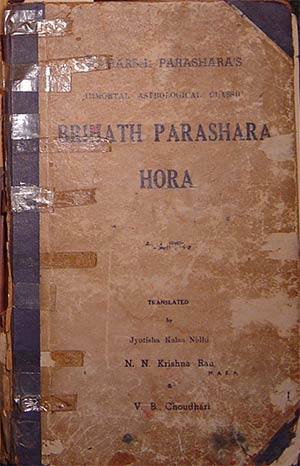
The copy of BPHS I got in Varanasi.
The book was a translation of some important chapters (not a complete translation) by N.N. Krishna Rau and V.B. Choudhuri, published in 1962. It was not well printed but the content mattered more to me than the form it was in. I recall I was especially happy because for the first time I could read an explanation of how the shodasavargas were to be used. I had been trying to use shodasavargas since 1977 and had even written a computer program to calculate them but was not really sure how to use them as no texts up to that time gave instructions on how to use them. I was also intrigued by the idea that the author, Parasara Muni, had indicated that each of the planets was an expansion of a different incarnation of Lord Krsna. I was determined to get a copy of this book. Unfortunately only about a thousand had been made by mimeograph copying almost 20 years earlier so it would be very hard to come by and no book sellers had heard of it.
By my good fortune I was introduced by a friend to an old brahmana, Pandit Dvivedi, from Varanasi who said he had a copy of the same book and would give it to me. I made arrangements to stop in Varanasi on my way to Vrndavana in August 1980 and acquired the book which I still have to this day. I studied the book diligently especially the use of the different vargas.
-
You may also be interested in:
- Well, It’s a Crazy Story
- Ashtamangala Deva Prashna
- On Inspiration
At that time while I was living in Kolkata (1980- May 1981) I was studying Vedic astrology with Sriman Harihara Majumdhar. I asked him what his opinion was of BPHS, I remember that he startled me by saying that unlike other well known texts BPHS started appearing only recently in the 1930-40s and that there was no standard version in Bengali. It was not till much later that I understood the significance of his statement.
In 1982 I was living and studying jyotish in Bangalore and Thiruvanantampuram. I recall having a discussion with my astrology teacher Sriman B.G. Sashikanta Jain regarding which system of house division should be used, one choice was for unequal house division based on statements of BPHS another was for Bhava = Rasi based on Brhat Jataka 1.4. The thing that I remember was that I was wondering how these two texts could give different views.
Later in 1982 I was discussing with my jyotish guru, Sriman B.G. Sashikanta Jain, about the lack of classical works translated into English. We made up a list of desired texts including BPHS. I then wrote a letter to Mr. Goel one of the owners of Ranjan Publications in Delhi submitting my desideratum. I never got a reply but I was more than pleasantly surprised when Santanam's translation and commentary on Hora Sara came out later that year and 2 years later they came out with Santanam's translation of the first volume of BPHS. And, later Santanam translated and published a steady stream of texts, many of which had been on my list.
From this point onward, BPHS became the "bible of astrology" replacing Brhat Jataka as a primary authority on the premise that BPHS was the older text. I also followed this trend. However I was somehow disturbed by what I perceived to be a focus only on BPHS and the demise of the tradition of studying other classics especially Brhat Jataka among the younger astrologers especially those who got into astrology via the internet and had never visited India.
Doubts about (modern)
Brhat Parasara Hora Sastra
In the summer of 1999 while reading B. S. Rao's annotated translation of Brhat Jataka with commentary of Bhattotpala (Mihira, 1986) I came across an interesting point in his commentary to the 7th chapter.
In Brhat Jataka 7.1 Varaha Mihira directly refers to Parasara Muni by the name of Saktipurva (son of Sakti). Later in Brhat Jataka 7.9. Rao mentions that the learned commentator Bhattotpala laments that while he has a copy of Parasara Samhita he was unable to acquire a copy of Parasara Hora which Mihira refers to in Brhat Jataka 7.1. This struck Rao as significant because it now made him doubt the authenticity of Jataka Candrika which is supposedly an abstract of Parasara Hora but much later than the time of Bhattotpala. On this basis Ajay Mitra Sastri (Shastri, 1969, p. 449) also doubted the authenticity of Laghu Parasari and BPHS.
In order to discredit the antiquity of the BPHS some persons have commented that there were many Parasaras in antiquity and that Varaha Mihira didn't mean Parasara Rishi, father of Vyasadeva, it was some other Parasara.
We reply first by asking who are these many other “Parasaras” they are referring to that Varaha Mihira would consider as a great authority in Jyotish?
We secondly note that Varaha Mihira identifies exactly which Parasara he means by identifying him as being the son of a particular Rishi, that is Śakti, who himself was the son of Vasista. Varaha Mihira in Brhat Jataka 7.1 calls him Śaktipurva, that is, having Śakti as a forefather.
“śaktipūrva:
pūrva m. having Śakti for a forefather', patr. of Parāśara VarBṛS.” M.M. William's Sanskrit-English dictionary.
So there is no doubt who Varaha Mihira thought he was quoting. Modern western-centric scholars 1500 years later with no access to his material are doing a disservice by such neo-colonial etic approach to the study of the history of Vedic astrology.
Why is this significant?
Bhattotpala lived in North India on the same latitude as Ujjain (Mihira, 1986, p.560). Bhattotpala finished his commentary on Brhat Jataka on 888 Saka which is either 833 AD (Vikram) or 968 AD (Shalivahan) (Mihira, 1986, p. 68). This was before the Islamic invasion of India with attendant destruction of libraries, places of learning, decline of scholarship and general decline of Krsna's Vedic civilization in North India.
His writings indicate that he had at his access many ancient works of jyotish, many of which we only know about because he quotes them in his commentaries (Mihira, 1986, pp. 17-19). It seems that he had access to various royal libraries in North India particularly Ujjain which was the native place of Varaha Mihira. Yet despite his living before the general destruction in the wake of the Islamic invasion and having access to a vast quantity of jyotish literature he was unable to see let alone acquire Parasara Hora quoted by Varaha Mihira. How then is it that we are able to get it 1000 years later with all the difficulties and loss associated with the passage of so much time?
Therefore there is great doubt as to the authenticity of the modern BPHS.
Importance of Brhat Jataka
In South India Brhat Jataka (and its commentaries) is held in the highest esteem, not BPHS. Why? Because of its many ancient commentaries by Bhattopala and others especially the Dasadhyayi of Talakkulathur Govindam Bhattathiri.
Visnu Nambudiri (fl. 1649 A.D.) the author of Prasna Marga, considered the master piece on Prasna literature, states the following, with notes by B.V. Raman (note the complete absence of any mention of BPHS):
Stanza 28. "Brhat Jataka by Varahamihira, though short, is a very suggestive treatise pregnant with ideas. Though difficult to be comprehended by even intelligent persons, yet with the aid of the commentaries of Bhattotpala and others, it is possible to understand the book.
NOTES: Compare Varaha Mihira's own admission, ... meaning that his work is "concise, of a variety of meter and full of meaning."
Stanza 29. "One wearing the garland of Varahamihira in his neck along with the necklace of Krishneeya can win laurels in any astrological assembly. [sic]
NOTES : Brhat Jataka deals with horoscopy and Krishneeya with Prasna. One well acquainted with these two books can, according to the author, safely claim good scholarship.
Stanza 30. "An astrologer who wants to make predictions should specially study Dasadhyayi carefully.
Stanza 31. "Without a thorough study of the Dasadhyayi, it would be difficult to make correct predictions. So say the learned.
Stanza 32. "One, who attempts to predict without studying the Dasadhyayi, would be like a man trying to cross an ocean without a boat.
Prasna Marga 1.28-32 (Nambudiri, 1991, pp. 19-21)
No Ancient Commentaries on
Brhat Parasara Hora Sastra
Another reason that casts doubt on the veracity of the modern BPHS is the complete lack of any ancient commentary on the text. The oldest commentary known to me is that of Devacandra Jha's Hindi commentary from the first half of the 20th century, that is, less than 100 years old. More recently are the previously mentioned English translations and commentaries of Santanam and Sharma.
In the preface of the first volume of his translation Santanam mentions that he had access to the following published texts:
1. Sri Venkateswata Press, Bombay, partly rendered in Hindi.
2. Hindi translation by Sitaram Jha (Master Khelari Lal, Varanasi edition)
3. Hindi translation by Devachandra Jha (Chaukambha edition)
4. Hindi translation by Ganesa Datta Pathak (Thakur Prasad edition).
And, that he chose the version of Sitaram Jha as the basis for his translation.Girish Chand Sharma gives no information regarding what text he translated.
N.N Krishna Rau in the preface of his (1962) translation of BPHS only mentions the Sri Venkateswata Press edition that he says was published 35 years earlier (1927) and seems to be the basis of his translation as no other source is mentioned.
It thus appears that all of these editions are of recent not ancient vintage.Why are commentaries important from a historical perspective?
Commentaries ensure that the corpus of the material in the text stays intact and allows us to track changes in the text. For example we know that the Bhagavad-gita has 18 chapters and 700 verses because all the commentaries from ancient to modern have the same number. If someone were to publish an edition of more or less than 700 verses it would be immediately detected as spurious.
But if a work has no commentaries then we can not know if there have been any changes to the text unless there is some other system (such as ghanapata) of keeping the text from changing.
Brhat Jataka commentaries
We can have reasonable faith and trust in the authenticity of the present version of Brhat Jataka because there are a number of commentaries on this text some of them very ancient. These commentaries preserve the text and its structure in a way that is hard to do without commentaries.
Shastri (Shastri, 1969, p. 26) gives the following information about commentaries on Brhat Jataka:
"Alberuni (1.158) informs us that the Brihajjataka was commented upon by Balabhadra who flourished sometime before Utpala (Bhatattopala)."
Shastri then goes on to mention seven other commentaries some without the name of the authors.
- Jagaccandrika aka Cintamani aka Vivrti by Bhattotapal
- Jataka-vivarana by Mahidhara
- Nilotpaliya -- not certain of the author
- Prakasa by Nityaprakasa Suri
- Dasadhyayi [Talakkulathur Govindam Bhattathiri]
- Nauka aka Hora-vivarana aka Varahamihira-hora-tatparya-sagara
- Subodhini
Kalyanraman adds:
"Brhat Jataka ... is stated to have more than twenty commentaries in Sanskrit itself, like Mudrakshari, Subhodhini, Sripatiyam, Bhatttopalavritti, besides, those in other languages. Dasadhyayi is one of such commentaries in Sanskrit, by Talakkulathur Govindam Bhattathiri. Perhaps next prominent one is Vivaranam of Rudra." (Kalyanraman, 2007, p. 203)
A recent Sanskrit commentary on Brhat Jataka is Apurarthapradarsika by A.N. Srinivasaraghava Aiyangar, published by Adyar Library, Chennai, in1951.
How to tell what is authentic in
Brhat Parasara Hora Sastra?
How to tell what is authentic in BPHS and what has been interpolated by later authors?
The first thing to consider is that Varaha Mihira refers to many previous and contemporary authors:
"Varaha Mihira was an encyclopedic writer and naturally he refers to a host of earlier or contemporary authors not only on astronomy and astrology but on various other subjects also. His equally learned scholiast Bhattotpala persistently styled him as 'the redactor of the entire Jyotihsastra,' and the author himself makes his position clear in [Brhat Samhita] 9.7. He declares, 'astronomy and astrology are the sciences based on Agama; should there be any difference of opinion (among ancient writers), it would not be proper on my part to put forward my view only; I shall, however, state the majority view.' The result is excellent, and his works form a valuable treasure-house of information about works and authors he consulted. His works assume still greater importance from the fact that they are the sole source of our knowledge about many works and their authors, but for these references, might have irrecoverably been lost to us." (Shastri, 1969, p. 424)
In the same chapter Shastri gives a list of all authors consulted by Varaha Mihira for composing Brhat Samhita pointing out that Varaha Mihira quoted Parasara many times (Shastri, 1969, pp. 447-449).
And, in Brhat Jataka (particularly chapter 7) Varaha Mihira names many previous scholars whose works he is familiar with these include but are not limited to: Maya, Yavana, Manitha, Parasara, Satyacarya, Visnugupta, Devasvami, Siddhasena and Jivasharma.
As "the redactor of the entire Jyotihsastra" it would necessitate Varaha Mihira's extensive familiarity with the works of the authors he names. Since he extensively quotes from the works of Parasara including his Parasara Hora Sastra we can presume his familiarity with its contents.
Varaha Mihira has extracted from these works the essence of what is important in Jyotish (Brhat Jataka 1.2) hence a comparison of the contents of Brhat Jataka and the modern BPHS may give us some clues as to what has been interpolated into the later.
We should also like to say that while a study of the Brhat Jataka will prove helpful in our search for the real BPHS it should not be our sole guide. There is Satyajatakam by Satyacarya which is still extant and was held in esteem by Varaha Mihira. Some works of the Yavana writers who also predated Mihira are still extant. And Hora Sara and Saravali will also be very helpful. These texts were all before the era of Bhattotpala. After his era I would suggest that we can also gain insight into the real BPHS from Sarvartha Cintamani and Jataka Parijata which were written relatively shortly after the era of Bhattotpala and in a region of India that had yet to experience the disruptions of the Islamic invasion and attendant destruction of libraries. So it is possible that these scholars had access to the real BPHS.
Obvious anomalies
House Systems
In the modern BPHS 5.20-24 we are taught how to calculate the unequal house system commonly known as the Sripati house system. However in Brhat Jataka 1.4 and Saravali 3.8 a different house system is taught where Rasi and Bhava are synonymous. In this system which ever Rasi the lagna appears is the 1st Bhava, the next Rasi is the 2nd Bhava, the next Rasi the 3rd Bhava etc. This is still followed by many traditional astrologers especially in the matter of Astamangala Prasna in Kerala. It is also the method used in Jaimini system. (Jaimini, 2006, p. ii) It is very obvious that this unequal house system was a much later interpolation into the modern BPHS. At some future date we will write an essay describing the faults of the unequal house system.
Remedial Measures
Chapters 88-97 of BPHS appear to be interpolations. Why? The chapters deal with remedial measures for various problems. The remedial measures that are recommended include the worship of various planets, nakshatra devas and other devas such as Siva and Varuna. This is completely contrary to what is known of the character and life of Parasara Muni who is known as a great devotee of Lord Krsna and His avataras.
Parasara was the father of an incarnation of Krsna (Vedavyasa), Srimad Bahgavatam 1.3.21. Maitreya states that Parasara learned the Srimad Bhagavatam from Sankhyayana and then he taught it to Maitreya, Srimad Bhagavatam 3.8.8-9. Parasara is also the speaker of the Visnu Purana. Both Srimad Bhagavatam and Visnu Purana are considered Satvik Puranas because the supreme object of worship is Lord Krsna and His avataras. Strict Vaisnavas initiated into Vaisnava mantras do not worship anyone other than Lord Krsna or His avataras as explained by Lord Krsna in Bhagavada-gita 18.66
sarva-dharman parityajya
mam ekam saranam vraja
aham tvam sarva-papebhyo
moksayisyami ma sucah
Abandon all varieties of religion and just surrender unto Me. I shall deliver you from all sinful reactions. Do not fear.
This a theme that Krsna has previously explained in earlier sections of the Bhagavad-gita.kamais tais tair hrta-jnanah
prapadyante 'nya-devatah
tam tam niyamam asthaya
prakrtya niyatah svaya
Those whose intelligence has been stolen by material desires surrender unto demigods and follow the particular rules and regulations of worship according to their own natures. Bhagavad-gita 7.20
And:
antavat tu phalam tesam
tad bhavaty alpa-medhasam
devan deva-yajo yanti
mad-bhakta yanti mam api
Men of small intelligence worship the demigods, and their fruits are limited and temporary. Those who worship the demigods go to the planets of the demigods, but My devotees ultimately reach My supreme planet. Bhagavad-gita 7.23
This is explained in more detail by Srila Gopala Bhatta Gosvami in the introduction of his Sat Kriya Sara Dipika wherein he quotes various sastras to support his claim:
As a person desires to cross the ocean by holding the tail of a dog, similarly an unintelligent man desires to deliver himself from the material bondage by worshipping others, giving up Lord Hari. Padma Purana
And:
svalpa api handi bhuyam
sam svadharma nirdita kriya
drstim kudrstir bhaktis tu
devatantapo samsraya
Even the slightest disreputable activity destroys a great quantity of virtue. Vast learning is destroyed by just the slightest wrong understanding. Bhakti is destroyed by the slightest dependence upon the demigods. Narada Pancaratra
Please refer to Sat Kriya Sara Dipika for a complete treatment of this topic. His Holiness Jayadvaita Swami has also published a detailed explanation of why we do not worship demigods.
These later interpolations also contradict what Parasara says in BPHS chapter 2 wherein he describes the planets as being manifestations of different avataras of Lord Krsna. (This section is consistent with the known teachings of Parasara.) If he understands the planets to be manifestations of Bhagavan Sri Krsna then it would be superfluous to take shelter elsewhere than at the lotus feet of the Supreme Personality of God Sri Krsna. Hence to find several chapters in which we supposedly find Parasara Muni recommending practices totally at variance with his own teachings that he spoke in Srimad Bhagavatam and Visnu Purana naturally make us question their inclusion in any work he authored.
-
You may also be interested in:
- From the Astrologer’s Diary: The Night Dacoits Stole Srimati Radharani
- Life of Govinda Bhattathiri, ]yotisha Acarya
- Are There Different Sizes of Infinity?
- Was Alexander the Great a Contemporary of Canakya Pandit?
Absence of Jaimini
One thing that is obvious is the complete absence of any reference to Jaimini astrology in Brhat Jataka which covers chapters 6, 31-35 (and sprinkled in chapters 8, 9 , 41-42, and 44) in the modern BPHS (Parasara, 1994).
The absence of any reference to Jaimini's system of astrology in Brhat Jataka could mean one of the following:
- Varaha Mihira didn't think Jaimini astrology to be useful.
- Or, Jaimini's system was not found in the version of BPHS available to Varaha Mihira and was a later interpolation.
It should also be noted that there is no mention of Jaimini system in the vast majority of the classic texts. The following texts on Jataka are Jaimini free:
- Narada Purana
- Yavana Jataka
- Satyajataka (these three were before Varaha Mihira)
- Brhat Jataka
- Hora Sara
- Saravali
- Brghu Sutra (date unknown)
- Mana Sagari
- Sarvartha Cintamani
- Jataka Parijata
- Phala Dipika
- Hora Ratnam
- Jataka Sara Dhipa
- Shambu Hora Prakasha
- Hora Makaranda
- Bhavartha Ratnakara
- Sanketa Nidhi
- Jatakadesa Marga
It should also be noted that all the authors up to the time of Saravali lived before Bhattotapala and from an inspection of their works evidently had access to Parasara Hora and were much influenced by him yet they have no trace of Jaimini in them.
The only texts that I could find that had any trace of Jaimini were Uttara Kalamrta 1.4.34-45 which has some elements of a simplified Jaimini. P.S. Sastri estimates that Uttara Kalamrta is a fairly modern work written sometime after the 16th or 17th century AD (Kalidasa, 2005, p. iv). And, Jataka Tattva, (allegedly) authored in 1871 by Mahadeva, also uses some concepts of Jaimini such as atmakaraka -- Jataka Tattva 1.66 (Mahadeva, 1941).
What one notices about these two texts is that though Jaimini concepts such as arudha and atmakaraka are used the framework is that of Parasara. Jaimini aspects are not used. It appears to be a blending of what the authors thought most useful in Jaimini added to Parasara in such a way as to not jar the axiomatic system of Parasara as would be the case if Jaimini aspects were also introduced.
The best known commentary on Jaimini Sutras is that of Nilakantha who is estimated by my Jaimini guru, Sriman Iranganti Rangacarya, to have flourished in the 17th century AD (Jaimini, 1995 p. i). We note that both Uttara Kalamrta and Jataka Tattva are contemporary or later than Nilakantha suggesting that he is their source on Jaimini in their works. This also strongly suggests that the chapters on Jaimini were inserted into the modern BPHS sometime after Nilakantha (17th century AD) by someone who was not an expert on Jaimini. We will comment why he was not an expert later.
The fact that Jaimini astrology is absent in all ancient classical works and only made its appearance after the commentaries of Nilakantha in the 17th century AD raises certain doubts about the Jaimini system.
Whereas, Nilakantha only had access to the first two chapters of Jaimini with others missing suggests that the work is much older than Nilakantha since part of it is already lost. (There is a controversy over whether Nilakanta commented on all four chapters or only the first two. And, Surya Narayain Rao (Rao, p. xiii) suggests that there were originally eight chapters.)
Whereas, there are the Vriddhakarikas, and Vanchhanathiyam as well as other lesser known commentators such as Krsna Misra (Phalaratnamala) and Somanatha Misra (Kalpalata ) who are considered earlier than Nilakantha but exactly how much earlier is open to speculation (guessing).
Whereas, others such as Raghava Bhatta (Jataka Sara Sangraha) and Nrisimha Suri (Sutrartha Prakasika) are also from 17th century.
Whereas, works such as Jaimini Padyamritam, have not had their dates ascertained yet but seem to be no earlier than 18th century AD.
This suggests the following possible scenarios:
- Jaimini system is perhaps at most 1000 years old if we are very liberal with the dates of the earliest commentators Vanchhanatha, Krsna Misra and Somanatha Misra. Therefore Jaimini sutras are not from remote antiquity like the original (not modern) BPHS.
- Jaimini Sutras are of the same antiquity as Parasara but it was not included in the original BPHS. Rather it was hidden for a very long time until they were brought to public notice by the commentary of Nilakantha in 17th century.
- Jaimini Sutras are of the same antiquity as Parasara but it was not included in the original BPHS. It was not popular with later astrologers and hence never included in their redactions of astrological texts.
We do not consider option 3 likely since we see that soon after the publication of Nilakantha's commentary on Jaimini sutras the authors of Uttara Kalamrta and Jataka Tattva used elements of this system in their work. And other authors in last century before the modern "revival" of Jaimini have used Jaimini system of ayurdaya (Ojha, 1972, pp. 236-238).
Revision February 7, 2011
It has been brought to our attention that since Jaimini Sutras extensively use the Katapayadi system and that since the first known usage of Katapayadi system is dated between 4th and 7th centuries AD then, unless it can be shown otherwise, it strongly suggests that Jaimini sutras was written after this time and are not of the same antiquity as the original BPHS, favoring scenario #1 above as correct.
Confusion created by “Jaimini”
material in modern
Brhat Parasara Hora Sastra.
We previously mentioned that the Jaimini material inserted into the modern BPHS was done by someone who didn't properly understand Jaimini Sutras. We would now like to briefly take up this subject.
My guru for Jaimini Sutra, Sriman Iranganti Rangacarya, translator and commentator of Jaimini Sutramritam with more than 40 years experience in Jaimini system, directly told me to strictly ignore whatever so-called Jaimini material found in BPHS because it will simply lead to confusion and contradictions. One example should suffice to see what quagmire one can end up in.
Argala as defined in the Jaimini School according to ancient commentaries can only be applied to a specific planet which has achieved a certain status by virtue of very clear criteria. I list them in increasing order of importance (Jaimini, 1995 p.12):
- A planet who aspects Janma Lagna.
- A planet who aspects both Janma lagna and its 7th house.
- The lord of the sign occupied by the Moon aspecting Janma lagna or Moon sign. He is called Kevala.
- The lord of the sign occupied by the Moon aspecting Janma lagna and Moon sign. He is called Yogada.
- A planet aspecting Janma Lagna in Rasi chart and Navamsa lagna in Navamsa chart or Drekkana Lagna in Derkanna chart. Also called Yogada.
- A planet aspecting Janma Lagna in Rasi chart and Navamsa lagna in Navamsa chart and Drekkana Lagna in Derkanna chart. Also called Yogada.
Rahu and Ketu can not be aspecting planets in this scheme. Aspects are strictly according to Jaimini system.
In 1, 5 and 6 instead of Janma Lagna it can be 5th or 9th but it must be applied consistently, by that I mean it must not be mixed together such as 5th in Rasi and 9th in Navamsa. It has to be 5th or 9th in both.
Thus according to classical Jaimini School argala is only to be applied to what Sriman Iranganti Rangacarya calls the "aspecting planet." Whereas, in the so-called Jaimini system found in BPHS, argala is applied indiscriminately to all planets and houses alike.
It would be beyond the scope of this essay to go into further comparison between the actual Jaimini system and what is found in the modern BPHS. But to mix the two is to simply court disaster.
One very senior astrologer who had mixed the two sources (Jaimini Sutras and BPHS) confidentially told me that he had been studying Jaimini system for more than 20 years and found it full of contradictions and confusions, he lamented that:"I have wasted 20 years of my life studying Jaimini."
What to speak of the confusion that arises if you mix the real Jaimini system with what is represented as Jaimini system in BPHS even more confusion will arise if the student of Parasara system mixes in Jaimini methods indiscriminately. P.S. Sastri warns "If the student of Parasara's text is not careful, he will mix up the two systems and get himself in contradictions and confusions." (Jaimini, 2006, p. i)
And, Sriman Iranganti Rangacarya jokingly illustrated to me the negative effect of mixing Jaimini and Parasara. Once there was a Telegu speaking man who also knew Sanskrit. A debate was going on. At one point the proper answer to a question was "horse." The man was so excited that when he answered the question he mixed up the Sanskrit word for horse asva with the Telegu word for horse gurru and his answer came out as gasva which was neither Telegu or Sanskrit and he lost the debate. So Iranganti Rangacarya told me this is the result of mixing Parasara and Jaimini. We again note that those texts like Uttara Kalamrta and Jataka Tattva that did try to blend the two system took a very conservative approach and only took from Jaimini (arudha and atmakaraka) what could be easily assimilated into Parasara system and nothing (like Jaimini aspects) that would clearly contradict the tenets of Parasara.
For more discussion regarding this topic of mixing Jaimini and Parasara systems see these: article 1, article 2, and article 3 at Jaimini Sutramritam a site dedicated to the authentic system of Jaimini as opposed to what is currently being taught by others.
We have only touched on the more obvious interpolations there are more but it is beyond the scope of this article to go into further detail.
What is actually from the original
Brhat Parasara Hora Sastra?
(For this we have used the Sagar edition as the reference text.)
The following is not an exhaustive treatment of the matter but only an introduction to further research. Hence, what follows will have to be adjusted and refined by more intense scrutiny.
The portions in the modern BPHS that appear to be from the original text are:
- The opening chapters (1-2) dealing with the creation of the universe and the incarnations of Lord Krsna.
- The sections dealing with basic descriptions of the Grahas, Rasis, Bhavas and Shodasavargas; chapters 3, 4, 7, 8, 13-25
- The intricate mathematical analysis of planetary positions yielding the diagnostic techniques of Shadbala, Vimshopaka, Ishta and Kashta, etc.; chapter 28-30.
- Various classes of Avasthas for determining the effect of the planets; chapter 47.
- The effects of each house lord in different houses; chapter 26.
- Yoga Karakas; chapter 36. And, Marakas; chapter 46.
- Ayurdaya; chapter 45.
- Astakavarga; chapters 68-74. But see my later comment on this topic.
- Udu Dasa system (based on the nakshatras). Although Varaha Mihira and Kalyana Varma both espouse Mula Dasa rather than Udu Dasa this is not an issue since they confine themselves to only one Dasa system while Parasara gives many. Also we know that Udu Dasa system is older than Varaha Mihira because Satyacarya, whom Varaha Mihira admired and quoted from extensively, used Vimshottari Mahadasa and Prithuyasasha the son of Varaha Mihira though writing on Mula Dasa also includes a short chapter on Udu dasa in Hora Sara. However, the Rasi based Dasa systems in BPHS may be interpolations from Jaimini system, but this is definitely not a certainty; they could well be independent and later adopted by Jaimini.
- The section on Yogas; chapters 37-44 may have some original material from Parasara but there also seems to be additions, notably the addition of Jaimini methods which bring into doubt the source of this material.
Is the modern
Brhat Parasara Hora Sastra useless?
Does the fact that there are interpolations in the modern BPHS mean that it is useless? No it doesn't mean that at all. However, one must be very careful to separate the interpolations from the real thing. Also there may be other techniques such as Sudarshan Chakra which may or may not be in the original BPHS but may still be valuable, they just need to be tested but not accepted blindly.
There was a real BPHS but we don't know exactly what it contained and can only guess and try to reconstruct its contents by examining the works of later authors like Satyacarya, Yavanas, Varaha Mihira, Prithuyashas and Kalyana Varma who had actually seen it. Others like Venkatesa Dikshita author of Sarvartha Cintamani and Vaidyanatha Dikshita author of Jataka Parijata could also be useful. The real BPHS is either lost, covered by the accretion of foreign material not in the original or hidden somewhere in some manuscript library.
There are millions of un-cataloged palm leaf manuscripts in India rotting in different venues. Once while I was driving in Tamil Nadu from Sri Rangam to Tiru-kottiyur we stopped at one of the many almost deserted ancient temples. There I came across a rather large room under lock and key whose walls were made of thick wire mesh containing what looked like mounds of refuse. On closer inspection I was horrified to see that it was actually tens of thousands of palm leaf manuscripts lying loose and jumbled. Who knows what treasures were contained in that mountain of palm leafs? They were probably being eaten by various insects and rats. At least being under lock and key they were not being burnt in cooking fires. The point being that there are many such sites in India where treasures of ancient knowledge are lying neglected and rotting.
Pramana
One thing that must be carefully noted regarding the modern BPHS and that is that it can not be used as a pramana (evidence) in any debate on techniques by citing it as an ancient authority if it contradicts another ancient authority. In 1987-88 when I was working with MATRIX Software to create the first professional Vedic Astrological software I found that there was a difference in how astakavarga was calculated in the modern BPHS and Varaha Mihira's Brhat Jataka. I (wrongly) assumed that since the modern BPHS was older than Brhat Jataka then the values it gave for astakavarga must be the original values for that system. Now I would take the views of Brhat Jataka as having precedence over modern BPHS. The same principle holds for any contradiction between modern BPHS and actual ancient texts. If a contradiction exists then it is likely I would give more preference to the other ancient text than to the modern BPHS.
Conclusion
Today what passes for BPHS is definitely not the original. There is an important core of material in it which seems to be part of the original text. More work needs to be done by correlating what is found in jyotish texts from before 1500 A.D. with what is found in the modern BPHS to ascertain what is authentic and what is interpolated. Jaimini system, unequal house divisions, etc. were interpolated into the modern text. Great care must be used when using this text especially when quoting it as pramana.
References:
Jaimini. (1995). Jaimini Sutramritam A Classic in Vedic Astrology (I. Rangacarya, Trans. Second ed.). New Delhi: Sagar Publications.
Jaimini. (2006). Jaimini Sutram (Complete) (P. S. Sastri, Trans. Revised ed.). New Delhi: Ranjan Publications.
Jaimini. (1984). Jaiminisutras (Rao, Suryanarian, B. Trans. Sixth ed. 2005 reprint). Delhi: Motilal Banarsidass Publishers Pvt. LTD.
Kalidasa. (2005). Uttara Kalamrta (P. S. Sastri, Trans.). New Delhi: Ranjan Publications.
Kalyanraman, V. (2007). Indian Astrology an Appraisal (First ed.). Nagercoil, India: CHB Publications.
Mahadeva. (1941) Jataka Tattvam. (Sastri, V. S. Trans). Bangalore: Sastri, V. Subramanya.
Mihira, V. (1986). Brihat Jataka (B. S. Rao, Trans. Fifth ed.). Bangalore: IBH Prakashana.
Nambudiri, V. (1991). Prasna Marga (B. V. Raman, Trans. second ed. Vol. 1). Delhi: Motilal Banarsidass Publishers Pvt. LTD.
Ojha, G. K. (1972). Predictive Astrology of the Hindus. Gurgaon: Shri Gopesh Kumar Pratishthan.
Parasara. (1984). Brihat Parasara Hora Sastra (R. Santhanam, Trans. First ed. Vol. 1). New Delhi: Ranjan Publications.
Parasara. (1994). Brhat Parasara Hora Sastra (G. C. Sharma, Trans. First ed. Vol. 1). New Delhi: Sagar Publications.
Pingree. A Descriptive Catalogue of the Sanskrit and Other Indian Manuscripts of the Chandra Shum Shere Collection in the Bodleian Library (Jyotihsastra, Part 1): Oxford University Press, 1984.
Shastri, A. M. (1969). India as Seen in The Brhatsamhita of Varahamihira (First ed.). Delhi: Motilal Banarsidass.
